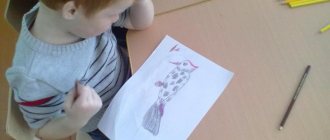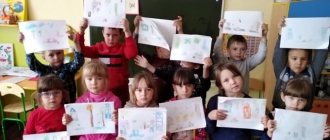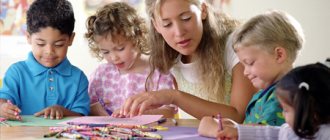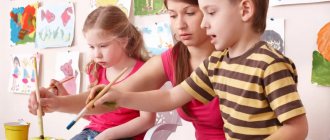MAGAZINE Preschooler.RF
“Magic Modeling” program for the senior groupGoal: Development of creative abilities in children of senior preschool age.
Objectives of the circle: introduce children to unconventional modeling techniques, coloring finished products; consolidation of knowledge about Dymkovo, Khokhloma, Gzhel paintings; fix relief, volumetric modeling; introduce the technique of making salt dough products; to develop an interest in performing creative works using different materials and methods; consolidate children's knowledge of materials that can be worked with and be able to use them correctly.
Explanatory note:
Our time requires creative, non-standard people who think and act for the benefit of the development of the individual and society. Therefore, the social order of society is to develop children’s creative abilities, the ability to think outside the box, not to be afraid to express opinions that differ from the generally accepted, to see the unusual in the ordinary.
According to psychologists and teachers, preschool age is the most favorable for the development of thinking and imagination - a mental process that forms the basis of creative activity. Therefore, the development of creativity is one of the main tasks of preschool education and upbringing.
The use of non-traditional modeling techniques in the practice of working with children works to solve several developmental problems at once:
- development of children's creative abilities (in all the diversity of this concept);
- development and improvement of fine finger motor skills;
- developing skills and abilities to work with various materials, devices and tools;
- acquaintance with new techniques and technologies;
- ability to apply them in practice.
Frequency of the circle: once a week for one academic year.
Duration of the circle: 25 minutes.
Expected student results:
Sculpts objects of various shapes using learned techniques and methods of sculpting;
Creates small plot compositions, conveying proportions, poses and movements of figures.
Creates images based on folk toys.
September:
1. Topic: “Apples and pears.” Gifts of autumn. Signs of autumn.
Goals and objectives: Practice rolling a ball, oval, flattening, using natural material to complement the craft.
Materials and equipment: Salt dough, dummies of fruits, stacks,
reproduction of paintings with fruits. (1/59)
2. Theme: “Sunflower”
Goals and objectives: Practice rolling a ball, oval, flattening, using natural material to complement the craft.
Materials and equipment: Salt dough, photo of a sunflower, stack, seeds. (11/14)
3. Theme: Decorative plate “Rose”. Gifts of autumn.
Goals and objectives: To develop the ability to sculpt a rose from individual parts, roll out balls, flatten, and make a flower of 6-8 petals. Develop finger flexibility and learn to see the end result.
Materials and equipment: Clay, stack (11/20, 3/61)
4. Topic: Painting the decorative plate “Roses” in the Gzhel style
Goals and objectives: To introduce children to folk art. Continue to develop the ability to paint products after drying, select paints, mix, to obtain the desired shade. Place the work on a plate.
Materials and equipment: Gouache, brushes, palette, dishes with Gzhel painting (8/85)
October:
1. Topic: “Prickly hedgehog.” Animal behavior in autumn.
Goals and objectives: Separately sculpt needles in the shape of a cone, connect the parts. Supplement the work with fungi and apples.
Materials and equipment: Colored salt dough, stack, slide with a picture of a hedgehog in the forest in autumn (11/12)
2. Topic: “The horse is beautiful, daring”
Goals and objectives: Continue to introduce children to folk art. Model a horse from a whole piece of clay. Develop finger flexibility and learn to see the end result.
Materials and equipment: Clay, stack, water, photo of the Filimonovsky horse (2/56)
3. Topic: “Kargopol goat”
Goals and objectives: Continue to introduce children to folk art. Model a horse from a whole piece of clay. Develop finger flexibility and learn to see the end result.
Materials and equipment: Clay, stack, water, photo of the Kargopol goat (1/112)
4. Theme: “Elephant”
Goals and objectives: Strengthen the ability to sculpt three-dimensional things and develop motor skills.
Materials and equipment: Plasticine, stack, photo of an elephant, sample of an elephant (5/14)
November:
1. Topic: “Ladybug” (on a leaf)
Goals and objectives: Learn to sculpt a ladybug from parts: head, body, using moldings, additional material for decoration. Use a leaf cutter. Be able to regulate the pressure when performing moldings.
Materials and equipment: Salt dough, leaf mold, toy, water, brush (12)
2. Topic: Coloring with “Ladybug” paints.
Goals and objectives: To develop skills of accuracy when coloring work. Be able to use unconventional drawing skills - with your finger, to draw dots. Exercise in ways of working with paints, designing work on a piece of paper.
Materials and equipment: Gouache, brush, glue (12)
3. Topic: “Panel with flowers” (sgraffito).
Goals and objectives: Familiarization with the technique of sgraffito - “scratched” on plasticine. plasticine,
Materials and equipment: cardboard, stack, painting with flowers
4. Topic: “Penguins on an ice floe.”
Goals and objectives: Continue to develop the ability to sculpt a figurine from a whole piece, using the techniques of rolling, stretching, flattening, cutting in stacks, conveying their characteristic features and proportions. Use foil when sculpting the body. Develop children's imagination and intelligence.
Materials and equipment: Salt dough, foil, foam. (11/8)
December:
1. Topic: Coloring with paints “Penguin on an Ice Floe”.
Goals and objectives: Continue to develop children’s ability to paint figures after drying, to combine them into a common composition. To develop children’s ability to accurately convey a conceived idea when coloring a product.
Materials and equipment: Gouache, brush, glue. (11/8)
2. Theme: “Christmas tree under the snow” (relief modeling)
Goals and objectives: Introducing children to a new modeling technique - plasticine stretching. Materials and equipment: plasticine, stack, card with Christmas tree (13)
3. Theme: “Snow Maiden”
Goals and objectives: To learn to reflect the impressions received while observing winter nature. Develop artistic and creative abilities.
Materials and equipment: Clay, model of the Snow Maiden (10/24)
4. Topic: Painting the Snow Maiden with Gzhel paintings.
Goals and objectives: Repeat the “Gzhel” painting with the children. Exercise in ways of working with paints, develop aesthetic perception and sense of color. Continue to develop the ability to see the end result of the planned work.
Materials and equipment: Gouache, brush, palette. Folk painting “Gzhel” (8/85)
January:
1. Theme: “Elegant Christmas tree”
Goals and objectives: To develop the ability in children to cut out a Christmas tree using a stencil, smooth out the edges with a brush moistened with water, and independently come up with decorations - balls, toys, beads. Develop finger flexibility. Use familiar sculpting techniques in a new creative situation.
Materials and equipment: Salt dough, “Christmas tree” stencil made of cardboard, stack, beads. (17)
2. Topic: Coloring with paints “Elegant Christmas tree”.
Goals and objectives: Continue to develop the ability to paint a Christmas tree with paints, develop skills of accuracy when doing work. Develop creative imagination and coherent speech when writing stories about the Christmas tree. When decorating the Christmas tree, use various additional materials
Materials and equipment: Gouache, brushes, glue, threads, beads, confetti. (17)
3. Topic: “Kargopol horse”
Goals and objectives: Continue to develop the ability to sculpt from a whole piece of clay.
Materials and equipment: clay, stack. (7/8)
4. Topic: “Decorating the Kargopol horse.”
Goals and objectives: To practice ways of working with paints, to develop aesthetic perception and a sense of color. Instill a love for animals and a desire to help them.
Materials and equipment: Gouache, brush, palette (7/8)
February:
1. Topic: “Bear-folk toy”
Goal: Continue to strengthen the ability to sculpt from a single piece. Introduce the traditions of potters.
Materials and equipment: plasticine, stack (9/10)
2. Topic: “Mug for Dad.”
Goals and objectives: To develop children’s ability to sculpt a mug, roll out plasticine in the form of a strip, a ball, press a depression in it, and pinch the edges. Sculpt the initial letter of the name for decoration. Develop fine motor skills and imagination in decorating a souvenir. Materials and equipment: Plasticine, stack (6/28)
3. Theme: “Hearts”
Goals and objectives: Consolidating the ability to sculpt objects or parts of them from dough, using the movement of the entire hand.
Materials and equipment: Colored salt dough, water
4. Topic: “Stork on the roof.”
February: Practice “painting over” a picture with plasticine. Cultivate an interest in creativity.
Materials and equipment: Plasticine, cardboard, cards with migratory birds, encyclopedia about birds (15)
March:
1. Topic: “Four-legged friend”
Goals and objectives: To develop the ability to use knowledge about the features of the appearance of animals in their work. Strengthen the skills and abilities acquired earlier (rolling, flattening, pulling, smoothing edges). Develop creative imagination and interest in work.
Materials and equipment: Stacks, plasticine, cardboard (10/28)
2. Topic: Signs of spring.”Flower meadow.”
Goals and objectives: Improving manual labor skills by modeling from colored dough.
Materials and equipment: Colored dough, stacks, water, slides with spring flowers (11/14)
3. Theme: “Basket with flowers”
Goals and objectives: Continue to develop children’s ability to roll out clay in an even layer, cut out a basket using a stencil, and scratch with a fork. Tie the flagella together for the handle and bottom. Sculpt familiar flowers and leaves. Develop imagination and the desire to give joy to others.
Materials and equipment: Clay, fork, basket stencil, stack. (11/14)
4. Topic: Coloring the basket and flowers.
Goals and objectives: To cultivate interest in creativity, collectivism, and aesthetic perceptions.
Materials and equipment: Gouache, brush. (11/14)
April:
1. Topic: “Amazing underwater world” (plasticineography)
Goals and objectives: Introduction to non-traditional drawing techniques (plasticine).
Materials and equipment: plasticine, stack (11/26)
2. Topic: “Rocket”.
Goals and objectives: To develop the ability to make a cone-shaped shape. Develop fine motor skills of the hands.
Materials and equipment: Salted dough, stack. Rocket photo (14)
3. Theme: Geometric man
Goals and objectives: Continue to develop children’s ability to paint crafts after drying, selecting the right colors. To develop the ability to accurately convey a conceived idea when coloring a product, to reveal the creative imagination of children in the process of work.
Materials and equipment: Clay, skewer, paints, brush (6/14)
4. Topic: “My dad is a fireman”
Goals and objectives: Continue to develop the ability to sculpt funny little people using the techniques of rolling balls, ovals, flattening, and pulling. Use matches and sticks to connect the parts. Develop the ability to work collectively.
Materials and equipment: Clay, matches, sticks, stacks (2/79)
May:
1. Topic: “St. George’s Ribbon.”
Goals and objectives: To develop the ability to roll out clay with a rolling pin and cut out shapes according to a template. Cultivate an interest in creativity.
Materials and equipment: Plasticine, template, stack
2. Theme: “Clover”
Goals and objectives: To consolidate the ability to roll balls of different sizes. Continue learning how to apply a relief pattern using a stack.
Materials and equipment: Plasticine, template, stack (3/38)
3. Topic: “Circus in Samara.”
Goals and objectives: Continue to develop the ability to notice and convey in modeling the characteristic features of an architectural structure.
Materials and equipment: Plasticine, stack, circus photo (16)
4. Topic: “Children on a walk.”
Goals and objectives: Continue to teach children how to convey movement in sculpting.
Materials and equipment: Plasticine, stack. (2/80)
Bibliography:
- Bondarenko T.M. “Complex classes in the senior group of kindergarten.” EC "Teacher", Voronezh, 2007
- Volchkova V.N., Stepanova N.V. “Lesson notes for the senior group of kindergarten”, Voronezh, 2008
- Davydova G.N. “Plasticineography. Floral motifs", M., 2009
- “From birth to school”, edited by N.E. Veraksy, T.S. Komarova, M.A. Vasilyeva M., Mozaika-synthesis, 2014.
- Petrova O. “Animals made of plasticine.” FST-PRESS KNIGA LLC, M., 2013
- Plomer A.L. “Making from clay” Kharkov, 2013
- Educational publication “Art for children. Kargopol toy. ed. "MOSAIKA-SYNTHESIS", M., 2008
- Utkin P.I. "Folk artistic crafts of Russia." M., 1984
- Educational publication “Art for children. We are making a folk toy.” ed. "MOSAIKA-SYNTHESIS", M., 2010
- Educational publication “Art for children. Khokhloma painting". ed. "MOSAIKA-SYNTHESIS", M., 2010
- Firsova A “Miracles from salt dough.” LLC "AIRIS-press", M., 2013
| Next > |
Preparing for a drawing lesson in the preparatory group
Preparation for a drawing lesson in the preparatory group is carried out with the development of artistic creativity. During the class, unconventional drawing techniques are improved using watercolors and wax crayons. Children should be able to distinguish between warm colors and shades.
How to prepare a preschooler for a drawing lesson
Types of drawing for preschoolers 6–7 years old
At the age of 6-7 years, children have a well-developed imagination. The teacher introduces them to the basic tools needed to create a drawing. Many talented children have a desire to improve their skills. They start drawing beautiful pictures. In the preparatory group, drawing on the theme “March” is carried out using an unconventional technique.
Important! When choosing a technique for creating drawings for children 6-7 years old, it is necessary to take into account that the use of paints, crayons, and pencils requires possession of certain skills, so in the first stages of creativity it is better to choose what will be easier for the child.
The teacher selects art material in advance. A preschooler can draw objects, favorite characters, decorative patterns, and pets. Teachers use colored pencils, watercolors, and gouache paints. Using a pencil you can create a linear shape. The child begins to draw one part after another, gradually adding various elements. After this, the outline should be colored with colored pencils.
Gouache and watercolor create shapes from a spot of paint, rather than from an outline. With the help of paints, a child can convey the richness of the environment, for example, the sea, the sun, the stars, etc. To create a masterpiece using a pencil, you need to be well versed in unconventional drawing techniques.
The preparatory group uses additional materials to create the drawing. Among them are the following:
- pastel;
- sanguine;
- colored crayons;
- charcoal pencil.
Using charcoal and sanguine, you can get a one-color design. Therefore, you need to focus on the form and conveying the texture of a certain object. Colored crayons greatly facilitate the process of painting large surfaces and large shapes. Pastels are designed to convey a variety of shades.
Modeling is a kind of children's fun that adds fun to the process of completing a task. Children love animals, cartoon characters, transport, toys. Modeling will allow you to master technical techniques. That is, the child first sculpts the object in a static position, and then bends its parts in accordance with the plan.
The appliqué activity introduces the preschooler to simple and complex shapes of various objects. The guys begin to create silhouettes that they cut out and paste. This method promotes the development of mathematical concepts.
An open drawing lesson is often conducted using a cotton swab and gouache. In the process of doing work, children learn to mix paints and get different shades.
Coloring pages on traffic rules for a preschooler 3-4 years old
Handouts needed for the lesson
To develop the ability to create drawings, it is necessary to prepare handouts, which consist of the following:
- template,
- gouaches,
- thin brush,
- jars of water,
- napkins.
Individual approach and team work with children
During the lesson, an individual approach is provided. The need for physical activity is realized through physical education sessions.
The teacher tells the children that guests have come to them, so they need to say hello. This technique is aimed at developing communication skills. Children should know how to behave with adults and peers. In addition, the teacher cultivates independence and accuracy. Every child who attends kindergarten should know how to monitor their posture.
Note! Before doing the work, the teacher introduces each child to the illustrations, looks at books with them, and also tells new material.
Lesson 17. Drawing “City (village) in the evening”
Program content. Teach children to convey in a drawing a picture of an evening city, color scheme: houses are lighter than the night air, multi-colored lights are burning in the windows. Strengthen the ability to draw up your plan, compositionally arrange the image on the sheet. Develop aesthetic feelings (colors, compositions). Learn to evaluate an expressive solution to a topic.
Lesson 18. Decorative drawing “Curl”
Program content. Teach children to decorate a sheet of paper with a large branch with curls (a typical main element in painting decorative items). Learn to use various familiar elements (flowers, leaves, berries, arches, small curls) to decorate branches. Develop multidirectional movements, ease of turning the hand, smoothness, unity of movements, spatial orientation on the sheet (decorating a branch with elements on the left and right). Develop a sense of composition. Continue learning to analyze drawings.
Lesson 19. Drawing “Late Autumn”
Program content. Teach children to convey in a drawing the landscape of late autumn, its color (the absence of bright colors in nature). Learn to use different materials to create an expressive drawing: gouache, colored wax crayons, a simple graphite pencil. Form an idea of neutral colors (black, white, dark gray, light gray), learn to use these colors when creating a picture of late autumn. Develop aesthetic feelings.
Lesson 20. Drawing according to plan “Draw what was the most interesting this month”
Program content. Teach children to select the most interesting ones from the impressions they receive, and develop the desire to display these impressions in a drawing. Strengthen the ability to draw with pencils and paints. Learn to express your idea most fully through drawing, and bring what you start to the end. Develop imagination.
Lesson 21. Drawing “We are going to a holiday with flags and flowers”
Program content. Learn to express impressions of the holiday, draw figures of children in motion (the child is walking, raised his hand with a flag, etc.). Strengthen the ability to convey the proportions of the human figure. Continue learning to draw the outline of the main parts with a simple pencil and color it beautifully with colored pencils. Learn to convey festive flavor in a drawing. Direct your attention to finding a good arrangement of figures on the sheet. Develop aesthetic feelings (colors, compositions).
Lesson option (for kindergarten in rural areas). Drawing “Harvest Festival in our village”
Program content. Teach children to convey holiday impressions: dressed-up people, decorated houses, cars carrying harvests. Strengthen the ability to arrange images on a sheet of paper and convey the human figure in motion.
November
Lesson 22. Application “Festive round dance”
Program content. Teach children to make an image of a person from appliqué parts, to find a place for their work among others. When gluing figures onto a common sheet, learn to select images that match well in color. Develop a sense of composition and color.
Lesson 23. Application “Fish in the Aquarium”
Program content. Teach children to cut out silhouettes of simple-shaped objects by eye. Develop hand-eye coordination. Learn to pre-prepare pieces of paper of the required size for cutting out images. Learn to achieve a distinct form. Develop a sense of composition.
Lesson 24. Lesson “Drawing illustrations for the fairy tale by D. N. Mamin-Sibiryak “The Gray Neck””
Program content. Cultivate an interest in creating illustrations for a literary work. To develop children’s ability to choose an episode that they would like to convey in a drawing. Learn to create fairy tale images in a drawing (forest, forest clearing, river and its banks, birds gathering in flocks flying in the sky; fox, hares, hunters, Gray Neck). Strengthen the techniques of drawing with paints, painting over a picture with a brush, sanguine; using a simple pencil for sketches when drawing complex figures (fox, hunter, etc.). Arouse in children interest in the drawings, a desire to look at them, and talk about them.
Lesson 25. Modeling “Child with a kitten (with another animal)”
Program content. Teach children to depict a simple scene in modeling (a child plays with an animal), conveying the movements of human and animal figures. Strengthen the ability to convey the proportions of the animal and human body. Practice using basic sculpting techniques.
Preparatory group. Senior preschool age. Children 6-7 years old
Notes on artistic and aesthetic development (AMD) for the preparatory group “Types of fine arts” Notes on direct educational activities in the preparatory group Topic: “Artistic and aesthetic development (AMD)
for children of the preparatory group.
Types of fine arts". (Painting, small sculpture and monumental sculpture)
Purpose: To summarize…
Summary of a lesson in senior preschool age on fine art using the plasticineography technique “Bullfinch on a branch” Purpose: to continue acquaintance with the unconventional technique of drawing plasticineography. Objectives: 1. Educational: expand children’s understanding of wintering birds, clarify the idea of the appearance of a bullfinch 2. Educational: cultivate the ability to complete a task, educate...



